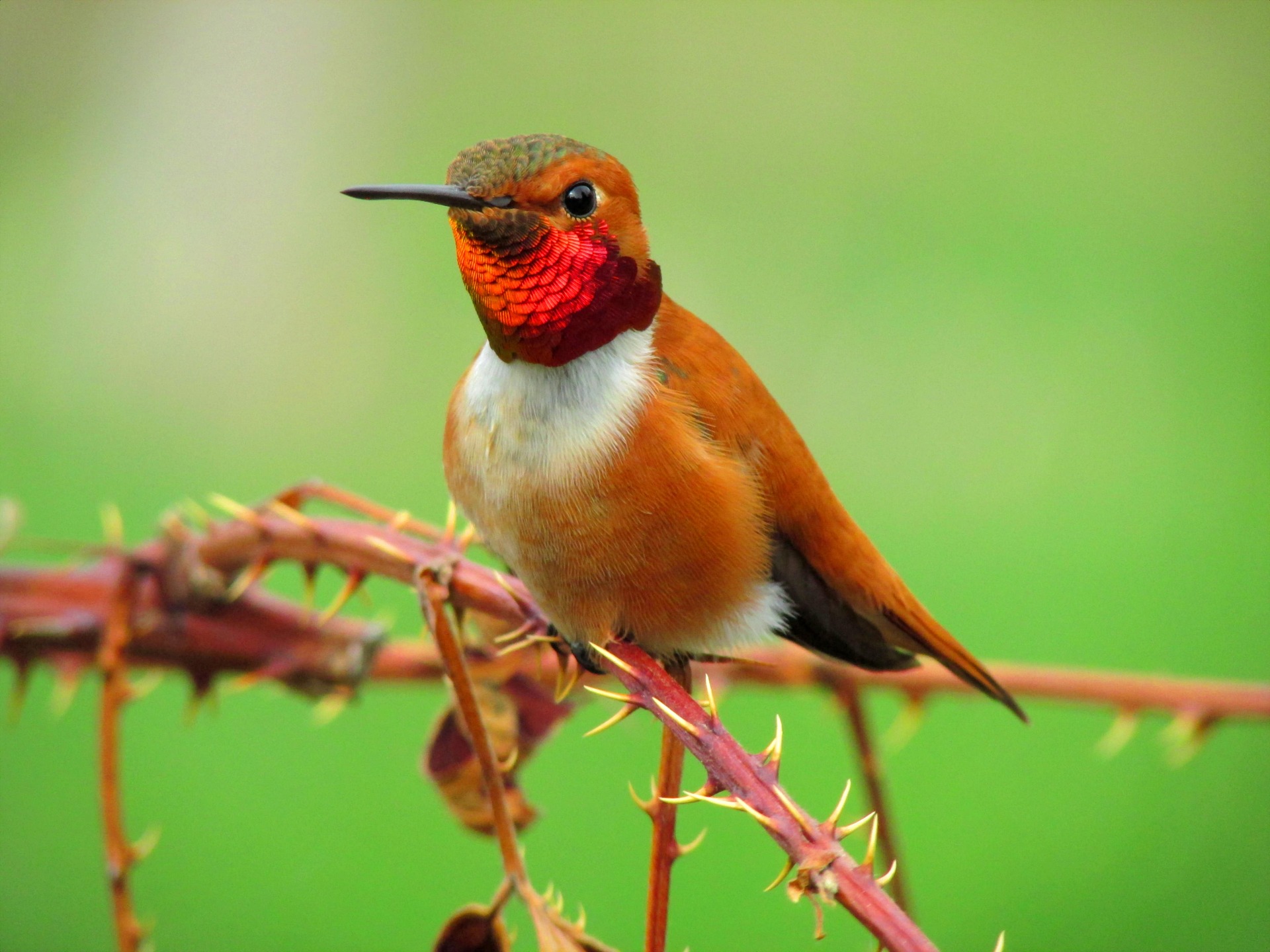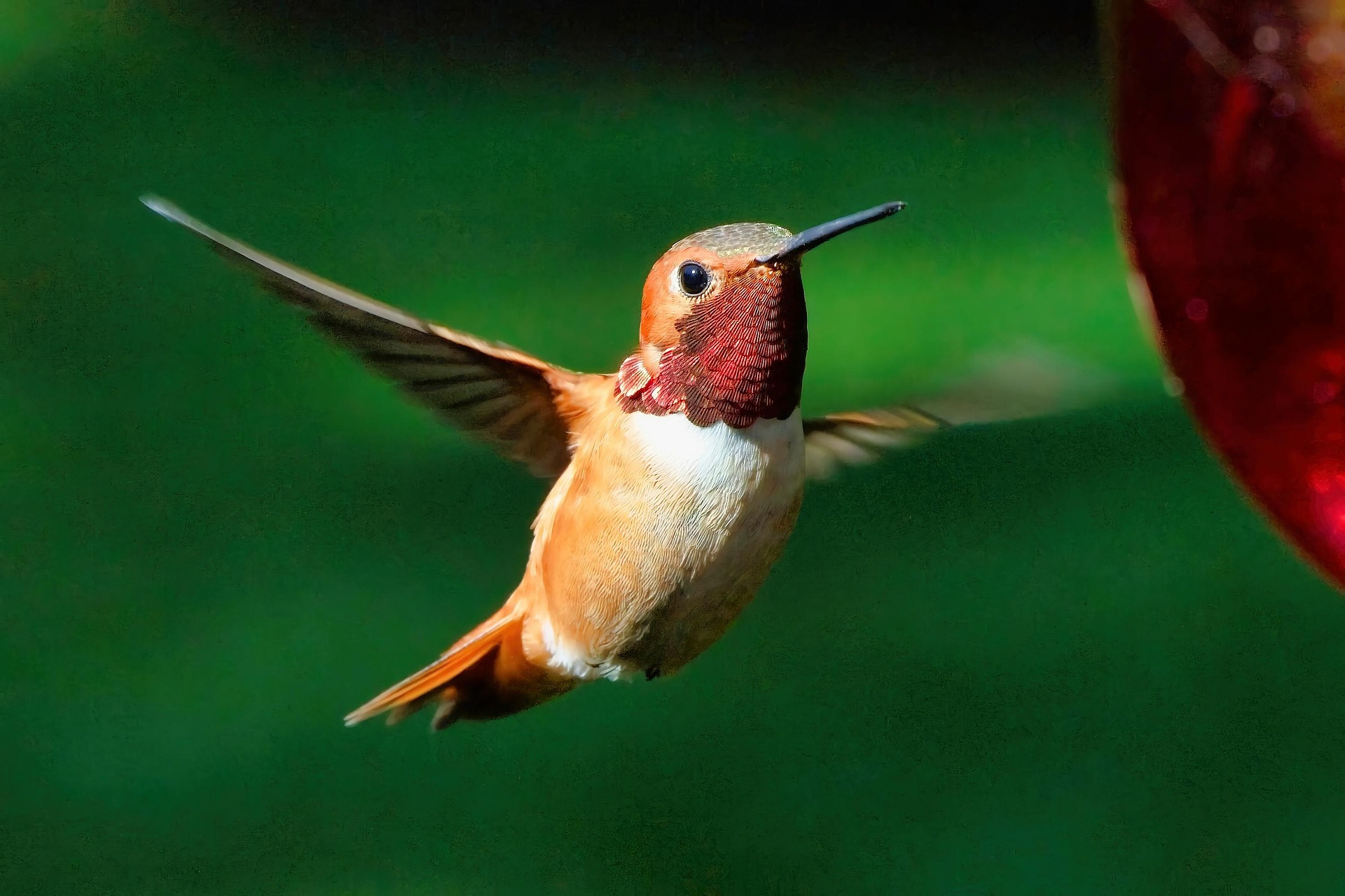The Rufous Hummingbird (Selasphorus rufus) is a migratory bird species belonging to the family Trochilidae (hummingbirds). It breeds in the western regions of North America and spends the winter months in Mexico and southern California. Weighing an average of 3.4 grams and measuring about 9.5 cm in length, this tiny bird is especially noted for the males’ brilliant orange throat feathers and copper-toned back. It is classified as Near Threatened (NT) by the International Union for Conservation of Nature (IUCN).
Morphological Characteristics
The Rufous Hummingbird is a small-bodied species with a high metabolic rate. Individuals weigh between 2.6 and 5.7 grams, with an average of 3.4 grams. Their body length is approximately 9.5 cm, and their average wingspan is about 11.4 cm. The bill is slender, black, and straight, becoming smoother in texture with age. Male individuals have bright orange gorget feathers and a metallic bronze-green back, while females display duller and more subdued coloration.
Juvenile individuals are naked and dark-skinned at hatching, with gray stripes along their backs. As they grow, feathering increases, and the throat feathers begin to show green and bronze hues. The undertail feathers of males, in particular, display iridescent metallic green and bronze markings. Once the plumage is fully developed, the males’ coloration becomes dominated by reddish-orange (rufous) tones. The species’ average basal metabolic rate has been measured at 0.0685 W.

Rufous Hummingbird (pixabay)
Distribution and Habitat
The Rufous Hummingbird (Selasphorus rufus) is a migratory species native to the Nearctic biogeographic region. During the breeding season, it is found from southeastern Alaska, extending through western Canada to the northwestern United States. Breeding generally occurs between April and July. By July, the birds begin migrating southward, traveling through the western United States to reach southern California and much of Mexico, where they spend the winter. Beginning in March, they migrate north again, reaching Washington State and surrounding areas by late April. The migration route is not linear but follows a loop pattern, with individuals making temporary stopovers, especially in the southwestern United States.
During the breeding season, the species prefers terrestrial habitats with abundant vegetation, such as meadows, orchards, parks, gardens, coniferous forests, and shrublands. In winter, it inhabits mountainous and forested regions of Mexico and southern California. The species is typically observed at elevations between 1,830 and 3,000 meters. Although it may pass through arid and semi-arid regions during migration, these areas are not used for long-term habitation due to limited food resources. Habitat selection in both breeding and wintering areas largely depends on the availability of nectar sources, which coincide with periods of flowering.
Feeding Behavior
The Rufous Hummingbird primarily feeds on nectar, but it also consumes small insects and other invertebrates to meet its high energy demands. On a daily basis, an individual must consume food equivalent to roughly half of its body weight. During migration or before energetically demanding activities, it increases its food intake to build up energy reserves.
In search of nectar, the species prefers brightly colored flowers, showing a strong sensitivity to red and yellow hues, which are often associated with successful feeding experiences. Individuals recognize food sources using visual cues and are known to return to the same flowers and feeding sites that previously provided nectar. Due to their ability to carry pollen, Rufous Hummingbirds play an important pollinator role within their ecosystems.

Rufous Hummingbird (pixabay)
Reproduction
The Rufous Hummingbird (Selasphorus rufus) breeds between April and July, producing a single brood per breeding season. Male individuals perform “J-shaped” aerial dives to attract females, and mating usually occurs close to the ground. The nest is constructed solely by the female, using soft plant materials, along with bark fragments, moss, and spider silk to provide flexibility and camouflage. Nests are typically well hidden within vegetation and located close to the ground.
The female generally lays two eggs per season, and the incubation period lasts between 15 and 17 days. The chicks fledge at around 15 days of age, becoming independent shortly afterward. Incubation and chick care are carried out exclusively by the female, although some reports suggest that both parents may occasionally contribute to feeding. Once the fledglings leave the nest, they do not return.
Conservation Status
The Rufous Hummingbird (Selasphorus rufus) is classified as Near Threatened (NT) by the International Union for Conservation of Nature (IUCN). This designation is based on a clear population decline trend. According to Partners in Flight (2019), the species shows an average annual decrease of approximately 2.1%, corresponding to an estimated 19% population loss over a ten-year period.【1】
The primary drivers of this decline include habitat loss, climate change, and environmental degradation along migratory routes. Although the species shows some tolerance to habitat disturbance caused by human activities and can even increase in certain areas due to the presence of artificial feeders, these localized positive effects do not offset the overall population decline. Currently, no specific conservation action plan has been implemented for this species; however, it is being monitored under the “Yellow Watch List” by Partners in Flight.


